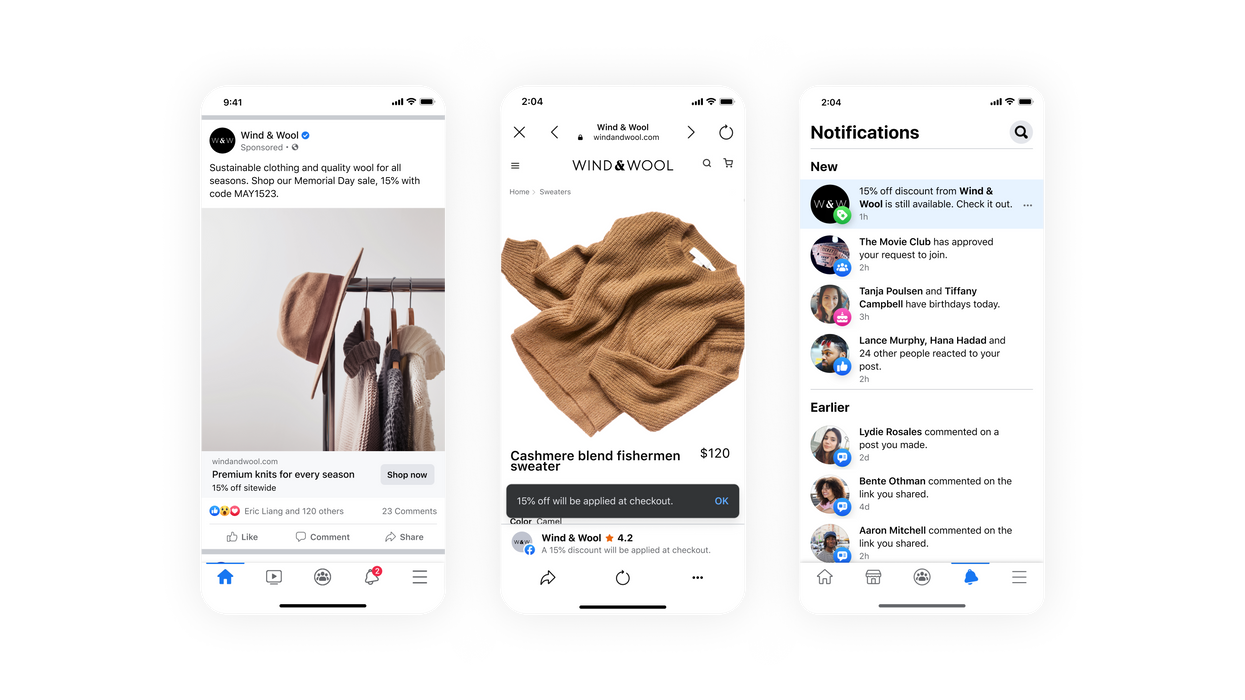Marketing
19 May 2023
Meta tests promotional ads to help lead users to deals
The Facebook and Instagram parent is also making updates to lead ads.

(Photo courtesy of Meta)
The Facebook and Instagram parent is also making updates to lead ads.

(Photo courtesy of Meta)
Meta is testing a new promotional ad format that are designed to help people find deals from brands.
Through this pilot, select advertisers on Facebook in the U.S. and UK will receive access to features that allow them to find, apply and manage deals. Promotions can be offered for seasonal sales, first-time purchase discounts and holiday promotions.
Meta offers this example of how it works:
“When people see an ad with a special promotion on Facebook, they can click through to claim the offer, which will automatically apply the discount code. If they don’t complete the purchase, they will receive a reminder notification before the deal ends,” the company wrote.
Meta found that 85% of shoppers seek out promotions before making a purchase. The new ads aim to make it easier to find deals, while in turn enabling brands and retailers to complete more sales. The ads also arrive at a time when consumers are more price-conscious following months of inflation and interest rate hikes that is giving way to a pullback in discretionary spending.
As Meta learns more through testing, it will consider adding features in the coming months.
The promotional ads arrive as Meta is also making upgrades to its lead ad products. Through this update question-and-answer forms can be automatically updated based on responses.
“For example, an educational institution can ask questions, such as, “What degree are you interested in?” Based on that answer, the subsequent questions would dynamically update to guide the person to more information about a specific program,” Meta writes.
Advertisers will also be able to soon overlay Instant Forms. Users will be able to engage with rich media on business pages, then submit information with autofill capabilities for names and email addresses.
There’s also a new step that businesses can take before setting up a lead ad campaign. Businesses using Meta’s new pages experience will also be able to add a contact form to the “Contact Us” button on their Facebook page. This allows people to inquire about a business and start a conversation through Messenger.
“These questions and forms give people a more tailored discovery and consideration experience for products and services they may be interested in, and help businesses find more qualified customers,” Meta wrote.
The updates come a week after Meta rolled out a new AI Sandbox that will allow the Facebook and Instagram parent to test generative AI features for advertising.Labor disputes on the West Coast could cause further disruption heading into peak season.
When the first half of 2023 is complete, imports are expected to dip 22% below last year.
That’s according to new data from the Global Port Tracker, which is compiled monthly by the National Retail Federation and Hackett Associates.
The decline has been building over the entire year, as imports dipped in the winter. With the spring, volume started to rebound. In April, the major ports handled 1.78 million Twenty-Foot Equivalent Units. That was an increase of 9.6% from March. Still it was a decline of 21.3% year over year – reflecting the record cargo hauled in over the spike in consumer demand of 2021 and the inventory glut 2022.
In 2023, consumer spending is remaining resilient with in a strong job market, despite the collision of inflation and interest rates. The economy remains different from pre-pandemic days, but shipping volumes are beginning to once again resemble the time before COVID-19.
“Economists and shipping lines increasingly wonder why the decline in container import demand is so much at odds with continuous growth in consumer demand,” said Hackett Associates Founder Ben Hackett, in a statement. “Import container shipments have returned the pre-pandemic levels seen in 2019 and appear likely to stay there for a while.”
Retailers and logistics professionals alike are looking to the second half of the year for a potential upswing. Peak shipping season occurs in the summer, which is in preparation for peak shopping season over the holidays.
Yet disruption could occur on the West Coast if labor issues can’t be settled. This week, ports from Los Angeles to Seattle reported closures and slowdowns as ongoing union disputes boil over, CNBC reported. NRF called on the Biden administration to intervene.
“Cargo volume is lower than last year but retailers are entering the busiest shipping season of the year bringing in holiday merchandise. The last thing retailers and other shippers need is ongoing disruption at the ports,” aid NRF Vice President for Supply Chain and Customs Policy Jonathan Gold said. “If labor and management can’t reach agreement and operate smoothly and efficiently, retailers will have no choice but to continue to take their cargo to East Coast and Gulf Coast gateways. We continue to urge the administration to step in and help the parties reach an agreement and end the disruptions so operations can return to normal. We’ve had enough unavoidable supply chain issues the past two years. This is not the time for one that can be avoided.”